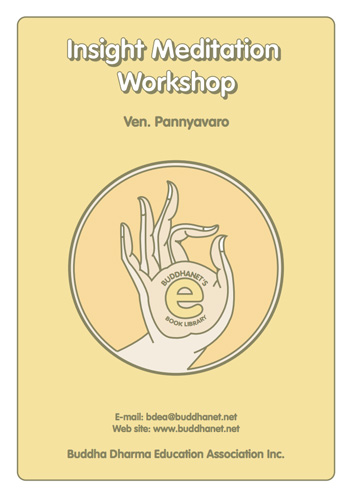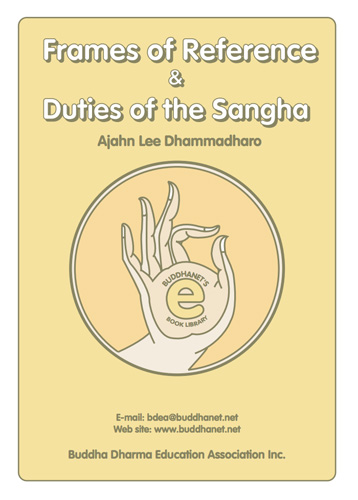 Most viewed - eBook Library Most viewed - eBook Library |

abhistudy.pdfAbhidhamma Studies (Buddhist Psychology)3893 viewsThe content of these studies is rather varied: they include philosophical and psychological investigations, references to the practical application of the teachings concerned, pointers to neglected or unnoticed aspects of the Abhidhamma, textual research etc. This variety of contents serves to show that wherever we dig deep enough into that inexhaustible mine, the Abhidhamma literature, we shall meet with valuable contributions to the theoretical understanding and practical realization of Buddhist doctrine.
|
|

medwshop.pdfInsight Meditation Workshop Online3882 viewsMeditation is the intelligent heart of the Buddha's way; the only criterion is that you should apply it to daily life. The purpose of this meditation course is not to create a system of beliefs, but rather to give guidance on how to see clearly into the nature of the mind. In this way, you can have firsthand understanding of the way things are, without reliance on opinions or theories - a direct experience, which has its own vitality. This course has been prepared with both beginners and experienced practitioners in mind.
|
|

allexistence.pdfThe 31 Planes of Existence3882 viewsThe suttas describe the 31 distinct planes or realms of existence into which beings can be reborn during their long wanderings through samsara. These range from the extraordinarily dark, grim, and painful hell realms all the way up to the most sublime, refined and exquisitely blissful heavenly realms. Existence in every realm is impermanent; in the cosmology taught by the Buddha there is no eternal heaven or hell. Beings are born into a particular realm according to both their past kamma.
|
|

now_know.pdfNow is the Knowing3863 viewsThis small book represents the wish of some of those fortunate enough to have received Dhamma teachings from Venerable Ajahn Sumedho to share them with others. The first section describes what taking the Three Refuges in the Buddha, Dhamma and Sangha means; and the second section is composed of passages from three or four different talks on the subject of Mindfulness of Breathing. Lastly, the book discusses happiness, unhappiness and Nibanna.
|
|

meritsutra.pdfSutra on the Merits of the Master of Healing3836 viewsSutra on the Merits of the Fundamental Vows of the Master of Healing, The Lapis Lazuli Radiance Tathagata; Sutra of the Sacred Formula of the Binding Vows of the Twelve Deva Generals to Enrich All Sentient Beings; Sutra of Tearing Away All Karma Veils. From the Chinese version of the Tripitaka Master Hsuan-tsang (T'ang, 650 C.E.) T. XIV, 450.
|
|

Recollections.pdfThe Ten Recollections - A Study Guide3809 viewsThe ten recollections are a set of meditation themes that highlight the positive role that memory and thought play in training the mind. They employ memory to sensitize the mind to the need for training, to induce feelings of confidence and well-being conducive for concentration, to keep the topics of concentration in mind, to produce tranquility and insight, and to incline the mind toward the deathless when tranquility and insight have grown sufficiently strong.
|
|

frames_ref.pdfFrames of Reference3808 viewsThis book on the frames of reference is based to some extent on my own thoughts and opinions. In some spots it may not be directly in line with the original text (Satipatthana Sutta), because my primary aim has been to get to the heart of the matter, so that it can be conveniently put into practice. The eBook also includes a section on the Duties of the Sangha, that is, the laws and regulations and disciplinary standards (Vinaya).
|
|

undrstnd.pdfTo Understand Buddhism3791 viewsThe teachings of Master Chin Kung are based on true sincerity towards others; purity of mind; equality in everything we see; proper understanding of ourselves and our environment; compassion by helping others in a wise and unconditional way. See through to the truth of impermanence; let go of all wandering thoughts and attachments; accord with conditions to go along with the environment. Be mindful of Amitabha Buddha - wishing to reach the Pure Land and follow His Teachings.
|
|

know-see.pdfKnowing and Seeing3767 viewsVen. Pa-Auk Sayadaw
Talks and Questions and Answers at a meditation retreat in Taiwan by Venerable Pa-Auk Sayadaw. This book details two approaches to insight meditation, namely, tranquility and insight and bare-insight meditation. These two methods are essentially identical, starting from four-elements meditation and continuing into insight meditation. In this book the reader has an explanation of the classic instructions for both methods. The talks in this book were given by the Sayadaw (teacher), from Pa-Auk, Mawlamyine, Myanmar, while he conducted a two-month meditation retreat at Yi-Tung Temple, Sing Choo City, Taiwan.
|
|

04_anapanasati_sutta.pdfThe Anapanasati Sutta3761 viewsThe Anapanasati Sutta is not an easy read, although the language itself is quite simple. But its structure is complex and dense, and this complexity raises serious questions about interpretation. The complexity of the structure creates ambiguity. Even the orthodox commentary sees certain passages as capable of different but simultaneous readings, referring to either serenity or insight practice depending on what approach to the practice the practitioner is taking.
We can see how Thich Nhat Hanh can take liberties with the text, but he does so to make the practice explained within it more accessible to ordinary lay people. Are we to assume that this was not the intention of the original compilers? Or can we see the complexity of the sutta as evidence of an attempt to create a discourse that different communities of practitioners could, quite legitimately, read in different ways? In any event, if we are to make sense of this sutta, and extract from it what it has to offer in terms of guidance on the practice, we need to read the structure of the text. It is not just the surface words that convey meaning, but the underlying networks that link the words.
|
|
| 347 files on 35 page(s) |
 |
 |
 |
10 |  |
 |
 |
|
